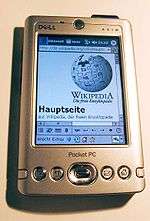Dell Axim
The Dell Axim family of personal digital assistants was Dell's line of Windows Mobile-powered Pocket PC Devices. The first model, the Axim X5, was introduced in 2002, while the final model, the Axim X51, was discontinued on April 9, 2007.[1]
Background
X5 family
Dell entered the personal digital assistant (PDA) market in 2002 with the debut of the Axim X5. The base-level Axim X5 had a 300 MHz Intel XScale PXA250 processor, 32 MB RAM, 32 MB flash ROM, a Type II CompactFlash slot, an SD/MMC slot, a 16-bit QVGA (240 × 320 dots) TFT display, a speaker, a microphone, and a base price of US$279. A high-end Axim X5 came with a 400 MHz Intel XScale processor, 64 MB RAM, and 48 MB flash ROM for US$349. Early models shipped with Pocket PC 2002, but an upgrade to Windows Mobile 2003 was offered and came preinstalled on some refurbished units. Despite rumours and speculations, further versions of Windows Mobile are unsupported. However, efforts have been made to port Linux to the system. Although the Axim X5 was regarded as an affordable Windows Mobile device at the time it was released, affordability came with a size penalty: The weight was 195 g (6.9 ounces) and the size was 127 × 81 × 18 mm (5 × 3.2 × 0.7 inches). The Axim X5 came with a rechargeable battery that would last for about 8 hours.
The Dell Axim X5 was superseded by the Dell Axim X3 and subsequently X30, a follow-up to the Dell Axim X5 boasting a more compact design and with lighter weight.
Many Dell Axim x5 units have issues with the touchscreen failing and a realignment failing as well, even after a hard reset. There is a design flaw inside the unit that causes this. The inside portion of the home button will rub against the touchscreen ribbon cable and eventually wear through the protective coating and ground out the touchscreen. The fix is to take the unit apart and put a very small piece of electrical tape over that portion of the ribbon cable. This requires removing both batteries, clearing all data from the device(similar to a hard reset) and delicate work in taking the unit completely apart.
X3 family
Dell Axim X3 was launched in October 2003, and came in three models: the Basic, Advanced and X3i which is the same as the Advanced model but adds WiFi 802.11b wireless networking. All featured replaceable battery, an SD slot, fast processor and transflective liquid crystal display. Unlike the X5, the X3 doesn't have a CF slot.
All three models look the same with the exception of the X3i which has a WiFi antenna nub on the top right corner. The Basic and Advanced models vary in processor speed and amount of memory. All models have Intel XScale PXA263 processors and Intel StrataFlash ROM.
The Basic has 300 MHz XScale processor, 31 MB of RAM and 32 MB of ROM. The Basic model comes with a USB sync cable (users could purchase a cradle separately). CF slot, Wifi capability and Infrared port included.
The Advanced model has a 400 MHz XScale processor, 64 MB of RAM and 64 MB of ROM. The Axim X3i adds WiFi to the Advanced model configuration. The Advanced and X3i comes with a chrome finish weighted USB sync cradle that can also charge a spare battery. In all other respects, these units are identical to each other.
X3 comes with a user replaceable 950 mAh Lithium Ion battery, which can be replaced by an optional 1800 mA extended battery which doubles run times.[2]
X30 family

The Dell Axim X30 was the first Dell Pocket PC to include Windows Mobile 2003 Second Edition on all models . This was also the first Pocket PC to include the Intel XScale PXA270 Processors.
The High-End X30 includes a 624 MHz processor making it the fastest Personal Digital Assistant or PDA at the time it was made. The mid-level model includes everything the High-End X30 does with the exception of the cradle, and uses a 312 MHz PXA270 Processor instead. Both the high-end and mid-level models had built-in 802.11b Wi-Fi Certification, Bluetooth 1.1 compliance, 64MB of Intel StrataFlash ROM, and 64MB RAM, while the entry-level model had 32MB SDRAM, 32MB of Intel StrataFlash ROM and no wireless capabilities. All X30 models include a standard SD/MMC/SDIO slot, replaceable/rechargeable battery, a 3.5" QVGA TFT 16-Bit color display, and Windows Mobile 2003 Second Edition.
SDHC Cards will not function. Only SD cards of 4GB or less will work.
X50 family
The Dell Axim X50 family was available in three models. The X50 low-end model used an Intel XScale processor at 416 MHz, 64 MB flash ROM, and retailed for $299 USD. The mid-range model had 128 MB of flash ROM, a 520 MHz processor, and was listed at $399. The high-end device, the X50v, had a VGA screen, 624 MHz processor, 128 MB flash ROM, and retailed for $499 at the time of release. In 2005 the Dell Axim X50 series received a Red Dot Design Award as a recognition for its design.
X51 family
The Dell Axim X51, released late September 2005, featured the same sleek design as the original X50, but replaced Windows Mobile 2003 Second Edition with Windows Mobile 5. The X51 also came with a larger ROM than the X50.
Like the X50, the X51 family came in three models. The X51 featured:
- 3.7" VGA LCD screen with 16-Bit Color and Portrait/Landscape Support (X51v only)
- 3.7" VGA is around 2.22" x 2.96" = around 216 pixels per inch
- 3.5" Quarter-VGA LCD screen with 16-Bit Color and Portrait/Landscape Support (X51 Low & Mid)
- Intel 2700G 3D multimedia accelerator with 16MB video RAM (X51v only)
- VGA-Out functionality (using an optional adapter cable), enabling the PDA to be connected to a monitor (X51v only)
- Built-In CompactFlash Type II expansion slot
- Built-In Secure Digital expansion slot
- Available Built-In 802.11b Wi-Fi Certification (X51 Mid & X51v only)
- Standard Built-In Bluetooth 1.2 Compliance
- Long-range IrDA interface
- Up to 256MB Intel StrataFlash ROM with 64MB on-board RAM
- Microsoft Windows Mobile 5.0 software with Windows Media Player 10 Mobile (Upgradeable to Windows Mobile 6.1 with a downloaded ROM update)
- RS232 port is also included, but even most of Dell's employees don't know this fact and the port only supplies TTL signal level. Dell has a RS232 cable for it though, even if it was never listed in their webshop.
The low-end X51 has an Intel XScale processor running at 416 MHz, 128MB flash ROM, and had a list price of $299 (before being discontinued). The mid-range model also has 128MB flash ROM, a 520 MHz processor, and retailed for $299 (from dell.com or £245.58 on www.dell.co.uk). The high-end X51v has a VGA screen, a 624 MHz processor, 256MB flash ROM, and had a list price of $379.
As of February 17, 2007 the low-end X51 has been discontinued and is not sold by Dell anymore.
There is also an unofficial upgrade to Windows Mobile 6.1 for the X51v. Despite its unofficial status, it has been tested and had gone through several prerelease versions before being released to the general public. An unofficial upgrade to Windows Mobile 6.0 exists for the X50. Known bugs include the lack of support for CompactFlash cards.
There is or was also an attempt to design a Linux implementation (based on Kernel version 2.6) for the X50 and X51 families of Axims, but it is still in a very early stage with major hardware components and functions (such as the backlight, sound, PCMCIA/Compact Flash, Flash Memory, Wi-fi, Bluetooth and USB connectivity) inoperative.
There is a partially functional port of Google's Android operation system to the Axim x51 under the AxDroid project. The current version of the build supports the Android Froyo release.
Specifications
| Model | Launch year | RAM (MiB) | ROM (MiB) | Slots | CPU | MHz | Screen | OS | WiFi | Bluetooth | More |
|---|---|---|---|---|---|---|---|---|---|---|---|
| X5 | 2002 | 32 | 32 | 1CFII,1SD | Intel XScale PXA250 | 300 | 240 x 320 | PPC2002/WM2003 | No | No | |
| X5 high end | 2002 | 64 | 48 | 1CFII,1SD | Intel XScale PXA255 | 400 | 240 x 320 | PPC2002/WM2003 | No | No | |
| X3 Basic | 2003 | 32 | 32 | 1SD | Intel XScale PXA263 | 300 | ? | WM2003 | No | No | USB sync cradle with CF, IR |
| X3 Advanced | 2003 | 64 | 64 | 1SD | Intel XScale PXA263 | 400 | ? | WM2003 | No | No | USB sync cradle with CF, IR, spare battery charging |
| X3i | 2003 | 64 | 64 | 1SD | Intel XScale PXA263 | 400 | ? | WM2003 | 802.11b | No | USB sync cradle with CF, WiFi, IR, spare battery charging |
| X30 low-end | 2004 | 32 | 32 | 1SD | Intel XScale PXA270 | 312 | 3.5" QVGA TFT 16-Bit | WM2003SE | No | No | |
| X30 mid-range | 2004 | 64 | 64 | 1SD | Intel XScale PXA270 | 312 | 3.5" QVGA TFT 16-Bit | WM2003SE | 802.11b | 1.1 | |
| X30 high-end | 2004 | 64 | 64 | 1SD | Intel XScale PXA270 | 624 | 3.5" QVGA TFT 16-Bit | WM2003SE | 802.11b | 1.1 | Cradle |
| X50 Standard | 2004 | 64 | 64 | 1CFII,1SD | Intel XScale PXA270 | 416 | QVGA | WM2003SE/WM5/WM6/WM6.1 | No | Yes | |
| X50 Advanced | 2004 | 64 | 128 | 1CFII,1SD | Intel XScale PXA270 | 520 | QVGA | WM2003SE/WM5/WM6/WM6.1 | 802.11b | Yes | |
| X50v | 2004 | 64 | 128 | 1CFII,1SD | Intel XScale PXA270 | 624 | VGA | WM2003SE/WM5/WM6/WM6.1 | 802.11b | 1.2 | IrDA, RS232 post, Intel 2700G 3D MMA w/16MB VRAM, VGA Out |
| X51 low-end | 2005 | 64 | 128 | 1CFII,1SD | Intel XScale PXA270 | 416 | 3.5" QVGA LCD 16-Bit | WM5/WM6/WM6.5 | No | 1.2 | IrDA, RS232 post |
| X51 mid-range | 2005 | 64 | 128 | 1CFII,1SD | Intel XScale PXA270 | 520 | 3.5" QVGA LCD 16-Bit | WM5/WM6/WM6.5 | 802.11b | 1.2 | IrDA, RS232 post |
| X51v | 2005 | 64 | 256 | 1CFII,1SD | Intel XScale PXA270 | 624 | 3.7" VGA LCD 16-Bit | WM5/WM6/WM6.1/WM6.5 | 802.11b | 1.2 | IrDA, RS232 post, Intel 2700G 3D MMA w/16MB VRAM, VGA Out |
See also
References
External links
| Wikimedia Commons has media related to Dell Axim. |
- Dell PDA Buying Guides for the United Kingdom
- Dell shuns Axim X5 and X3 users
- Dell Axim X50v as per Tom's Hardware
- Dell Axim X30 as per Tom's Hardware
- Dell Axim PDA on Porter Electronics (Website where they are still available)
